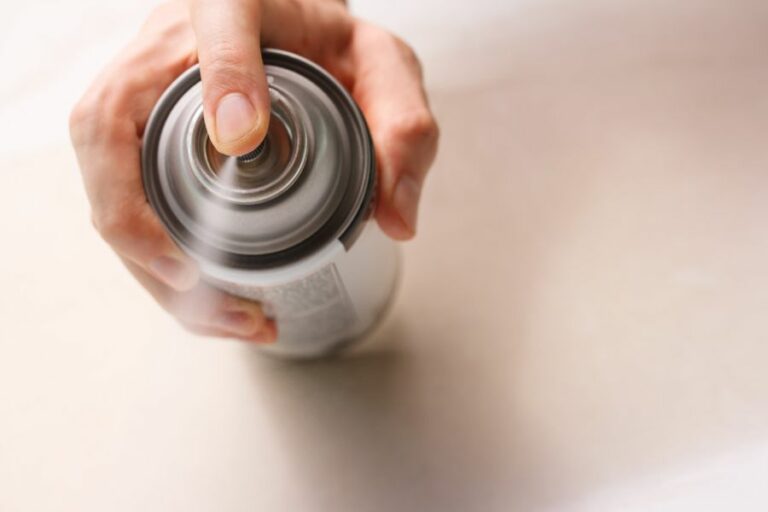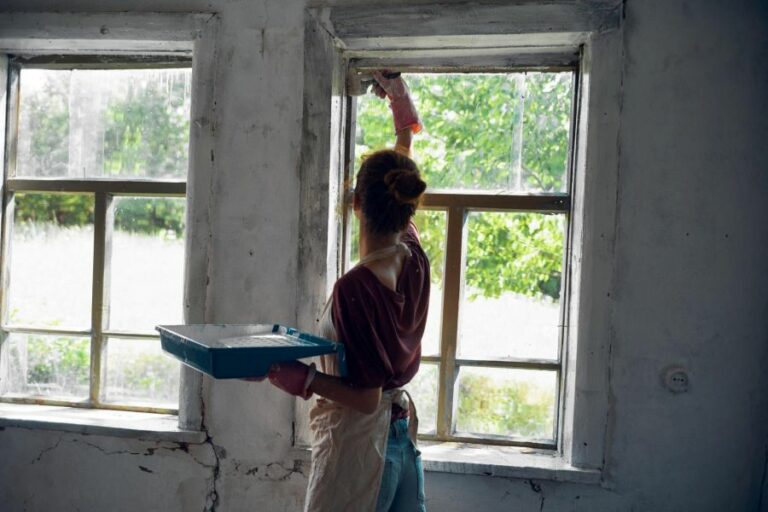Outdoor Foundation Paint, 25 Things You Should Know
Are you tired of constantly repainting the exterior of your house due to unsightly peeling and fading? This blog post on outdoor foundation paint offers the perfect solution for long-lasting, weather-resistant beauty. Discover the secrets behind choosing the ideal paint that offers exceptional durability, enhanced curb appeal, and protection for your home’s foundation. Don’t let the elements wreak havoc on your home any longer.
Outdoor foundation paint:
Choosing the right exterior foundation paint is crucial for durability and protection, with acrylic, elastomeric, and waterproof options available. Proper preparation involves cleaning, repairing damage, and priming the surface. Using suitable tools and applying two coats of paint is essential, and regular maintenance prolongs the lifespan and appearance of the foundation paint job.

Discover the perfect outdoor foundation paint to elevate your home’s exterior aesthetics and protect against the elements. Learn about various types, expert tips, and application best practices for long-lasting, visually appealing results that add value to your property. Don’t miss it!
Contents
- 1 Exterior Foundation Paint for Outdoor Use
- 2 What Type of Paint Should You Utilize for an Exterior Foundation?
- 3 Is it Possible to Apply Paint on the Exterior Foundation?
- 4 Is it Possible to Apply Paint on the Exterior Surface of a Concrete Foundation?
- 5 What is the process for painting an exterior concrete foundation wall?
Exterior Foundation Paint for Outdoor Use
• Choosing the Right Type of Paint
When it comes to exterior foundation paint, there are several types to choose from, each with its own set of advantages and disadvantages. It is important to select the right type of paint based on your specific needs, as well as your home’s materials and environmental conditions.
– Acrylic (Water-Based) Paint
Acrylic paint is a popular choice for outdoor foundation paint because it is easy to apply, dries quickly, and can be easily cleaned with water. It is highly resistant to peeling and cracking, making it an ideal option for foundations made from concrete.
I recommend using acrylic paint for most foundation painting projects, as it offers a good balance of durability and ease of application. Additionally, water-based paint is more environmentally friendly, as it does not contain harmful solvents found in oil-based paints.
– Elastomeric Paint
Elastomeric paint provides extra protection for your foundation thanks to its unique elastic properties that allow it to expand and contract with the concrete. This can help prevent cracking and other structural damage caused by the natural movement of your home.
While elastomeric paint may be more expensive than its acrylic counterpart, its increased durability and flexibility make it a smart investment for those who live in areas prone to extreme temperature swings or significant seismic activity.
– Waterproof Paint
Waterproof paint may be the best option for your home if you live in a climate with heavy rainfall or frequent flooding.
Specially formulated to resist water intrusion, this paint can help protect your foundation from leaking or absorbing excess moisture, which could lead to mold growth and structural damage.
It is important to note that waterproof paint should not be your only method of preventing water damage. Proper drainage, sealing cracks, and maintaining your home’s exterior are also crucial to keeping your foundation in good condition.
• Preparing Your Foundation for Painting
Before you can begin painting your foundation, you must first prepare the surface to ensure a long-lasting and smooth finish. This process typically involves cleaning, repairing any damage, and priming the surface.
– Cleaning the Surface
Begin by removing any loose paint, dirt, or debris from the surface of the foundation. A power washer can be incredibly useful for this step, as it efficiently blasts away grime and old paint.
Alternatively, you can use a stiff brush and mild detergent to scrub the surface clean. Be sure to allow the foundation to dry completely before applying any paint or primer.
– Repairing Damage
Next, inspect your foundation for any cracks, holes, or other damage that may need repair. If you do find minor damage, use a suitable patching product to fill it in, such as a concrete crack filler or epoxy paste. For larger damage, it may be necessary to consult a professional for proper repair.
– Priming the Surface
To achieve the best results, it is essential to apply a high-quality primer to your foundation before painting. The primer serves as a basecoat, helping the paint adhere and preventing it from soaking into the porous concrete.
Choose a primer specifically designed for masonry surfaces, and allow it to dry according to the manufacturer’s instructions.
• Painting the Foundation
Now that your foundation has been prepped, it’s time to move on to painting.
– Choosing the Right Tools
Selecting the appropriate tools for your foundation painting project can make the process much more efficient and enjoyable.
I recommend using a long-handled roller with a thick nap, as it can easily apply paint to textured and uneven surfaces. You may also need a high-quality paintbrush for cutting in around windows, doors, and other details.
– Applying the Paint
When applying the paint, be sure to work in sections and maintain a wet edge to prevent unsightly lap marks. I suggest beginning at the top of the foundation and working your way down, allowing the paint to be pulled downward by gravity.
Apply at least two coats of paint, allowing the first coat to dry completely before applying the second. Remember to follow the manufacturer’s instructions for drying times and proper ventilation.
• Maintaining Your Painted Foundation
To keep your newly painted foundation looking its best, it’s essential to perform regular maintenance and inspections. This typically includes:
- Keeping the area around the foundation clean and free of debris
- Promptly addressing any drainage issues or water damage
- Inspecting the paint for signs of peeling, cracking, or other damage
- Repainting as needed, typically every 5-10 years, depending on your specific type of paint and environmental conditions.
By following these guidelines and investing in high-quality outdoor foundation paint, you can protect your home’s structural integrity and enhance its curb appeal for years to come.
What Type of Paint Should You Utilize for an Exterior Foundation?
An exterior foundation is not only essential for the structural integrity of a building but also plays a crucial role in its overall aesthetics. One way to protect and enhance the appearance of an exterior foundation is by applying appropriate paint.
• Factors to Consider When Selecting Paint for Exterior Foundations
Several factors come into play when choosing the most suitable paint for an exterior foundation. Here are some of the critical aspects to take into account:
– Durability and Weather Resistance
Exposure to harsh weather conditions and fluctuating temperatures can make the exterior foundation prone to damage over time. In this regard, it is essential to select paint that offers durability and weather resistance to ensure long-lasting and efficient protection.
– Moisture and Water Resistance
Since foundations are prone to moisture and water seepage, the chosen paint should have high water resistance properties. This can prevent water damage, mold, mildew, and other dampness-related problems.
– Breathability
Breathable paint that allows moisture to escape from the wall surface is crucial in averting structural damage caused by trapped moisture. It is crucial to consider paints with excellent breathability when painting exterior foundations.
– Aesthetic Appeal
The paint should not only offer protection but also enhance the visual appeal of the building. Consider a paint color that complements the existing building design while adhering to any local building codes or homeowner’s association requirements.
• Types of Paint for Exterior Foundations
There are several types of paint available on the market specifically designed for use on exterior foundations. Some of these include:
– Masonry Paint
Masonry paint is specifically formulated for use on surfaces such as brick, concrete, and stone. This type of paint offers excellent protection against weather elements, UV rays, and water damage while also being highly breathable.
Typically, masonry paints come in a variety of colors, making it easier to find the perfect shade for your building’s foundation.
– Elastomeric Paint
Elastomeric paint is a high-performance, water-resistant paint that provides excellent coverage and durability.
This type of paint can fill and bridge small cracks on your foundation while maintaining its elasticity, which ensures that the paint does not crack or peel due to temperature fluctuations or foundation settling.
Additionally, elastomeric paint offers excellent breathability and can resist mold and mildew growth.
– Acrylic Latex Paint
Acrylic latex paint is another option to consider when painting exterior foundations. This water-based paint is known for its ease of application, quick drying time, and resistance to water damage.
Additionally, acrylic latex paints are flexible and can expand and contract with the foundation without cracking or peeling.
• Preparing Exterior Foundation for Painting
Before applying the chosen paint, it is crucial to prepare the foundation adequately to ensure a long-lasting painting job. The following are steps to consider in the preparation process:
– Inspection and Repair
Inspect the foundation for cracks, water damage, mildew, and other issues that may require fixing before applying the paint. Repair any damaged areas, allowing enough time for the fixes to dry before commencing the painting process.
– Cleaning the Surface
A clean surface is crucial for paint adhesion. Use a pressure washer to remove dirt, dust, and debris from your foundation walls thoroughly. If mold or mildew is present, ensure to use a suitable cleaner and brush to remove them before rinsing the surface.
Allow the foundation to dry completely before applying paint.
– Priming
Using a high-quality masonry primer is recommended for better paint adhesion and longer-lasting results. Priming the surface also helps in ensuring a uniform color application and seals porous foundation surfaces, preventing moisture infiltration.
• Painting Tips and Recommendations
Once the foundation is prepared, follow these tips for a successful painting job:
- Choose the right time to paint; avoid painting during hot days or under direct sunlight, as this might cause the paint to dry too quickly, affecting the paint’s adhesion and finish.
- Use quality painting tools and invest in high-quality brushes, rollers, or sprayers to ensure an even and smooth paint application.
- Apply multiple coats for better protection and a uniform finish; apply at least two coats of paint.
- Allow adequate drying time to follow the paint manufacturer’s recommendations regarding drying time between coats and before exposing the foundation to rain or other weather elements.
In conclusion, choosing the right paint for exterior foundation walls is essential in ensuring efficient protection and enhancing the visual appeal of your building. By evaluating factors such as durability, water resistance, breathability, and aesthetics, you can select the most suitable paint for your foundation.
Furthermore, proper preparation and execution of the painting process will guarantee a long-lasting and visually pleasing outcome.
Type of Paint | Description |
|---|---|
Acrylic latex | Water-based paint that is durable, easy to clean, and provides good coverage. Suitable for most exterior surfaces. |
Elastomeric | A flexible and waterproof paint that is excellent for protecting the foundation from water damage and extreme weather conditions. |
Masonry | Designed specifically for concrete and masonry surfaces, provides a breathable and waterproof finish. |
Oil-based enamel | A durable and long-lasting paint that provides a smooth and hard finish, suitable for surfaces exposed to the elements. |
Concrete stain | This is not a paint but a stain that penetrates concrete surfaces and provides a colored, protective finish. |
Is it Possible to Apply Paint on the Exterior Foundation?
Painting your home’s exterior foundation can be a great way to improve its appearance and protect the structure.
• Reasons to Paint Your Outside Foundation
– Aesthetic Appeal
Painting the exterior foundation of your home can greatly enhance its overall look. A fresh coat of paint can hide cracked or discolored concrete, making the foundation look smoother and more polished.
– Protection
Coating the foundation with paint can also provide protection against water and other environmental elements. This can help prevent damage from moisture intrusion and extend the lifespan of your foundation.
– Resale Value
A well-maintained and attractive foundation can increase your home’s curb appeal, which may, in turn, boost its resale value. Prospective buyers might be more interested in a home with an appealing foundation that is free of cracks or other signs of damage.
• Choosing the Right Paint
There are a few factors to consider when selecting the right paint for your exterior foundation.
– Type of Paint
I recommend using a high-quality, water-resistant, and durable paint designed specifically for concrete and masonry surfaces. These types of paints are specifically formulated to adhere to concrete and provide long-lasting protection.
– Color
Selecting the appropriate color for your foundation is crucial. Generally, you should choose a color that complements your home’s exterior paint and design. Neutral colors like gray, beige, or white are popular choices, but you can also opt for a more vibrant shade if it matches well with your home’s aesthetic.
– Finish
Exterior foundation paints are available in a variety of finishes, including flat, satin, semi-gloss, and gloss. Flat or satin finishes are often preferred for foundation painting as they can help hide minor imperfections and offer a more subtle appearance.
• Preparing the Foundation for Painting
Before you start painting your foundation, it’s crucial to ensure the surface is clean and properly prepared.
– Clean the Surface
Use a pressure washer or a scrub brush with water and a mild detergent to remove dirt, debris, and any loose or peeling paint from the foundation. Be sure to rinse the surface thoroughly to remove any soap residue.
– Repair Cracks and Damage
Inspect your foundation for any cracks or signs of damage. Minor cracks can be filled with silicone or acrylic caulk, while larger cracks and damages might require a concrete patch or repair product. These repairs should be allowed to fully cure before applying paint.
– Allow Surface to Dry
It’s essential to let the foundation dry completely before painting. This may take a few days, depending on weather conditions.
• Painting the Foundation
Follow these steps to ensure a professional and long-lasting finish.
– Apply a Primer
Applying a primer specifically designed for concrete or masonry surfaces can enhance the adhesion, durability, and appearance of your paint job. Use a brush, roller, or paint sprayer to apply the primer, following the manufacturer’s instructions for application and drying times.
– Paint the Foundation
Once the primer is dry, you can begin painting your foundation. Start by cutting in around the edges of the foundation with a brush, then use a roller or paint sprayer to cover the larger areas.
Apply at least two coats of paint, allowing the first coat to dry according to the manufacturer’s instructions before applying the second coat.
– Inspect and Touch Up
After the final coat of paint has dried, inspect the foundation for any areas that may require touch-ups or an additional coat of paint.
• Maintaining Your Painted Foundation
Once your outside foundation has been painted, it’s essential to maintain the paint job to ensure its longevity.
- Regularly inspect your foundation for signs of wear or damage.
- Clean the surface as needed to remove dirt and debris.
- Touch up any peeling or chipping paint.
- Reapply paint as necessary to maintain the color and protection of your foundation.
• Final Thoughts
Painting your outside foundation is an excellent way to enhance your home’s appearance and protect the structure from potential damage.
By choosing the right paint, properly preparing the surface, and following the steps provided in this guide, you can achieve a professional-looking finish and enjoy the benefits of a well-maintained foundation for years to come.
Question | Answer |
|---|---|
Can you paint outside foundation? | Yes, you can paint the outside foundation. However, you should properly clean and prepare the surface and use the appropriate paint and tools to ensure a lasting and well-protected foundation. |
Is it Possible to Apply Paint on the Exterior Surface of a Concrete Foundation?
Absolutely, painting the outside concrete foundation is not only possible, but it can also be beneficial in protecting and enhancing the appearance of your home.
• Benefits of Painting Outside Concrete Foundation
There are numerous benefits to painting the outside concrete foundation, including:
- Aesthetics: Painting the foundation can refresh your home’s facade and improve its curb appeal. With the right color and finish, your concrete foundation can blend seamlessly with your home’s design.
- Protection: A coat of paint can act as a barrier against potential damage from weather conditions, moisture, and other environmental factors.
- Maintenance: Painted concrete is easier to clean and maintain, as dirt and debris can be easily removed by hosing it down or wiping it with a wet cloth.
- Enhanced Durability: A well-applied layer of paint can improve the longevity and resistance of your concrete foundation.
• Types of Paint for Concrete Foundation
It is crucial to choose the appropriate paint for your foundation to ensure longevity and proper adhesion. Here are my top recommendations for concrete foundation paint.
– Masonry Paint
Masonry paint is specifically designed for concrete, brick, and stucco surfaces. This type of paint provides excellent adhesion, durability, and resistance to weather and moisture. I recommend using acrylic-latex masonry paint for its superior performance and ease of application.
– Elastomeric Paint
Elastomeric paint is an excellent option if your concrete foundation has existing hairline cracks or experiences frequent movement. This type of paint is a high-build coating with superior flexibility, and it can bridge and fill small cracks while maintaining its appearance.
• Preparing the Concrete Foundation for Painting
Proper surface preparation is essential for the successful adhesion and durability of the paint. Follow these steps to prepare your concrete foundation for painting:
- Inspect and repair: Inspect the foundation for any larger cracks, chipped paint, or damage. Repair any defects using a patching compound designed for masonry surfaces, and follow the manufacturer’s instructions.
- Clean the surface: Pressure wash the foundation to remove dirt, debris, and any loose or flaking paint. Allow the surface to dry for at least 24 hours before proceeding.
- Apply masonry primer: If the surface is porous, very rough, or has never been painted before, apply a masonry primer before painting. Priming ensures proper paint adhesion and longevity, and it can also help block stains and provide a more uniform paint coverage.
• Painting the Concrete Foundation
Once the surface has been properly prepared, you are ready to paint your concrete foundation. Follow these steps for a successful outcome:
- Choose the right weather conditions: Avoid painting during extreme temperatures or wet conditions, as this can affect the paint’s adhesion and drying times. The ideal temperature for painting outside is between 50F and 85F with low humidity.
- Mix the paint: Stir the paint thoroughly to ensure consistent color and texture.
- Apply the first coat: Use a brush, roller, or sprayer to apply the first coat of paint. Ensure even coverage, and avoid excessive paint application, which can lead to drips or an uneven finish.
- Allow to dry: Allow the first coat of paint to dry according to the manufacturer’s instructions. This typically takes between two to four hours, but it may vary depending on temperature and humidity conditions.
- Apply a second coat if necessary: Assess the coverage and finish of the first coat. If needed, apply a second coat of paint to achieve desired results. Allow the second coat to dry completely before reattaching any hardware or making contact with the surface.
• Maintaining Your Painted Concrete Foundation
Proper maintenance will help prolong the life of your painted concrete foundation. Here are my recommendations for keeping it in excellent condition:
- Inspect the foundation periodically for damage or wear, addressing any minor issues before they escalate.
- Keep the foundation clean, removing dirt and debris with a gentle hosing or wiping with a wet cloth.
- If desired, apply a masonry sealer to further protect the painted surface from weather and moisture damage.
By following these guidelines, you can improve the appearance and longevity of your outside concrete foundation. With the right paint, preparation, and maintenance, your painted foundation will remain attractive and functional for years to come.
Question | Answer |
|---|---|
Can you paint outside concrete foundation? | Yes, you can paint the outside concrete foundation using the appropriate type of paint and preparation techniques. Ensure the surface is clean and dry before applying a suitable primer, followed by a high-quality masonry paint designed for use on concrete surfaces. |
What is the process for painting an exterior concrete foundation wall?
Painting an exterior concrete foundation wall is an excellent way to enhance the aesthetic appeal of your property while also providing added protection and longevity to the concrete itself.
• Preparing the Concrete Surface for Painting
Before you can effectively paint a concrete foundation wall, it’s crucial to properly clean and prepare the surface. This ensures proper adhesion of the paint and a better overall result.
– Remove Debris and Loose Concrete
Use a stiff brush or broom to remove any dirt, debris, and loose concrete from the exterior of your foundation wall. Be thorough in your inspection and cleaning, as dirt and loose materials can interfere with the adhesion and overall quality of your paint job.
– Repair Cracks and Holes
Inspect the surface of the concrete foundation wall for any cracks, holes, or other imperfections. These imperfections should be repaired with a suitable concrete repair product, such as hydraulic cement or concrete patch. Follow the product’s instructions for use and allow it to cure for the recommended time.
– Clean the Surface
Using a pressure washer, thoroughly clean the entire surface of the concrete foundation wall. This will remove any remaining dirt, dust, or debris and ensure the best possible adhesion of the paint. Be sure to allow the surface to dry completely before moving on to the next step.
• Priming the Concrete Foundation Wall
Priming the concrete surface is critical to achieving a professional-looking result and ensuring that the paint adheres properly. Using a high-quality concrete primer will help seal the concrete and provide a more uniform base for the paint to adhere to.
– Choose the Right Primer
Select a primer specifically designed for use on concrete surfaces, such as a masonry or concrete primer. It’s essential to choose a primer that is compatible with the type of paint you plan to use.
– Apply the Primer
Using a paint roller or spray gun, apply the primer generously to the entire surface of the concrete foundation wall. Be sure to cover the entire surface, including any corners, edges, and crevices. Allow the primer to dry for the recommended time.
• Selecting the Right Paint for Your Concrete Foundation Wall
Now that your foundation wall is primed and ready for painting, it’s essential to choose the right type of paint for the specific conditions and requirements of your project.
– Choose the Right Type of Paint
Select a paint that is specifically designed for use on concrete and masonry surfaces. It’s important to choose a paint that is appropriate for exterior use, as some paints are not designed to withstand weather conditions and may fade, peel or crack over time.
– Choose the Right Finish
Consider the desired finish for your exterior concrete foundation wall. Paints with a satin or semi-gloss finish will provide a more durable and easier-to-clean surface than flat or matte finishes, which may be more susceptible to dirt and moisture.
– Plan Your Color Scheme
Select the color you wish to paint your concrete foundation wall. Consider the colors of the other elements of your home’s exterior, such as siding, trim, and roofing, to create a cohesive and attractive color scheme.
• Applying Paint to the Concrete Foundation Wall
With the surface fully prepared and the paint selected, it’s time to get to work painting your concrete foundation wall.
– Use the Proper Tools
Ensure you have the appropriate tools for the job, such as a paint roller, paintbrush, or paint sprayer. Rollers are ideal for large areas, while brushes work well for smaller spaces, edges, and detailed work. A paint sprayer can make the job easier and more efficient, especially on large or uneven surfaces.
– Apply Multiple Coats
Start by applying a thin, even coat of paint to the entire surface of the concrete foundation wall. Allow the first coat to dry completely before applying a second coat. Adding multiple coats will provide better coverage and protection for your concrete foundation wall.
Be sure to follow the manufacturer’s instructions on drying times and appropriate application techniques.
– Allow Adequate Drying Time
After applying the final coat of paint, allow the surface to dry for the recommended time before reinstalling any fixtures or landscaping elements that may have been removed during the painting process.
• Final Thoughts
Painting an exterior concrete foundation wall can greatly improve your property’s curb appeal and provide added protection for the concrete itself.
By carefully preparing the surface, selecting the right primer, and using high-quality paint, you can achieve a professional-looking result that will last for years to come. Follow these expert tips and recommendations to ensure a successful and satisfying paint job.
| How do you paint an exterior concrete foundation wall? | |
|---|---|
| 1. Clean the surface | Remove dirt, debris, and dust from the wall by power washing or scrubbing with a stiff brush. |
| 2. Repair cracks and holes | Fill any cracks or holes with concrete patching compound and let it cure according to the manufacturer’s instructions. |
| 3. Apply concrete sealer | Apply a concrete sealer to the wall to help prevent moisture penetration and improve paint adhesion. Allow the sealer to dry completely. |
| 4. Prime the surface | Apply a high-quality masonry primer to the wall using a roller or brush. Allow the primer to dry according to the label instructions. |
| 5. Choose exterior paint | Select a durable, weather-resistant paint that is specifically designed for masonry surfaces. |
| 6. Paint the wall | Apply the paint using a roller or brush, following the manufacturer’s recommendations for coverage and drying time. It may be necessary to apply a second coat for the best results. |
| 7. Inspect and touch up | After the paint has dried, inspect the wall for any missed spots or uneven areas. Touch up as needed. |







